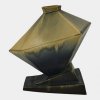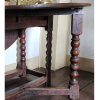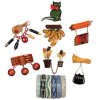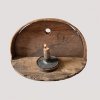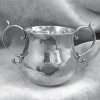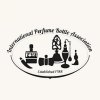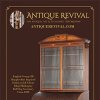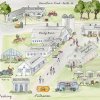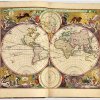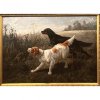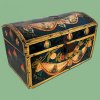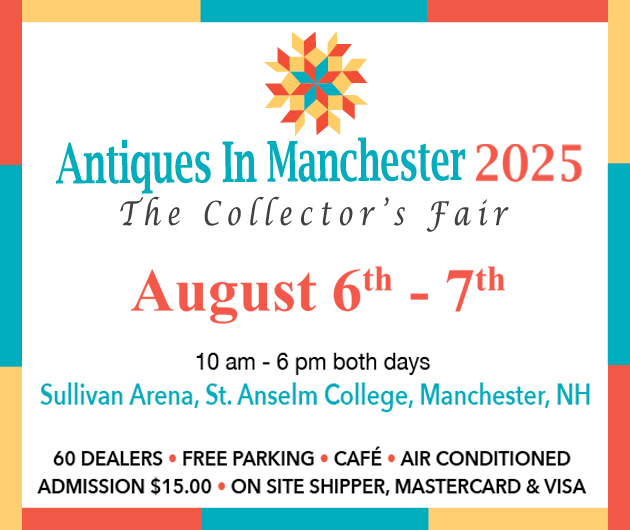Cowan's Americana
December 10th, 2016
Cowan’s Auctions, Cincinnati, Ohio
Photos courtesy Cowan’s Auctions
A grouping of mirrors offered in the last half-hour of a cataloged Americana sale held by Cowan’s Auctions in Cincinnati, Ohio, on December 10, 2016, were a good reflection of the strong bidding experienced throughout the day.
Described as primitive, the four mirrors included a folk art example with a carved and painted frame in the form of an eagle, the piece said to have come from a farm in Corinth, Kentucky. Despite missing some of the surround, the 15¾" x 8" mirror was clearly the gem of the bunch. The other examples were smaller and of a more traditional form. Estimated at $400/600, the lot sold for $3480 (includes buyer’s premium). In large part, that’s the kind of day it was—with good Americana bringing strong prices.
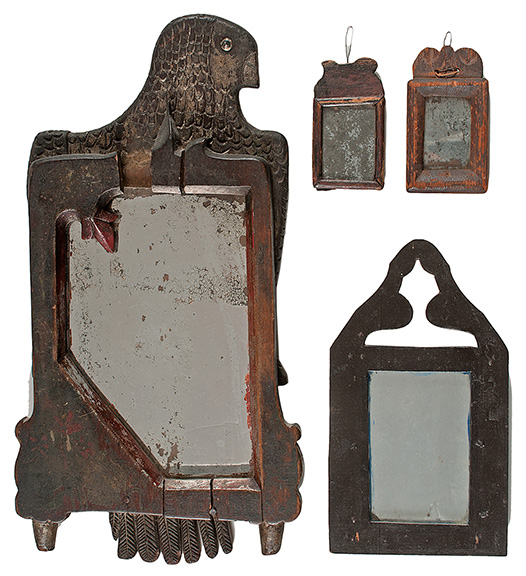
Four primitive mirrors, the carved and painted folk art eagle purportedly from a farm in Corinth, Kentucky, the remaining looking glasses with crests of varying designs, two of the mirrors pocket size, American, 19th or early 20th century, the eagle 15¾" x 8", the smallest mirror 3¾" x 2", the eagle missing a portion of the surround, all with wear, $3480. Cowan’s photo. Cowan’s Auctions, Cincinnati, Ohio, December 10, 2016.
The mirrors came from the collection of the late Drs. James and Betty Sutherland of Cincinnati. The couple began collecting in the 1960s and continued for half a century. Cowan’s catalog noted, “They traveled widely, buying from Ohio dealers such as Clark Garrett and David Good, and further afield from legends such as Peter Tillou.”
Wes Cowan, chairman and principal auctioneer at Cowan’s, recalled his first visit to the Sutherlands’ home, where few people in the antiques trade had been allowed. “From basement to attic, Americana was arrayed on shelves, atop chests, in cupboards, on window ledges, or literally piled in dresser drawers. The experience was truly like visiting Aladdin’s cave,” he wrote in the auction catalog.
 It wasn’t the only collection of note in the sale. Also highly touted were items from the descendants of the Benkard family of Oyster Bay, New York, and Tucson, Arizona. Main players in the family included Bertha King Benkard, said to be a scion of New York society and a close friend of Henry Francis du Pont; and her daughter, Bertha Benkard Rose, described by Cowan’s as “a child of privilege and a woman of taste and means.” The family had ties to Winterthur, the Museum of the City of New York, the New-York Historical Society, and the Society for the Preservation of Long Island Antiquities.
It wasn’t the only collection of note in the sale. Also highly touted were items from the descendants of the Benkard family of Oyster Bay, New York, and Tucson, Arizona. Main players in the family included Bertha King Benkard, said to be a scion of New York society and a close friend of Henry Francis du Pont; and her daughter, Bertha Benkard Rose, described by Cowan’s as “a child of privilege and a woman of taste and means.” The family had ties to Winterthur, the Museum of the City of New York, the New-York Historical Society, and the Society for the Preservation of Long Island Antiquities.
“We were fortunate to have two good collections to offer—both from estates, and both from consignors who understand the current market,” Cowan noted after the auction. “These two factors combined to allow us to offer some great material with very reasonable presale estimates, which ultimately helped attract aggressive bidding.”
Items from the Benkard collection set the tone early and included a China trade school painting, The Hong Kong Harbor with American, British, and European Ships, picturing a busy harbor with hong merchant warehouses lining the shore. Dating to the early to mid-19th century, the 19½" x 35½" (sight size) oil on canvas was in its original Chinese Chippendale frame and sold for $22,200. A second China trade school oil painting of a similar scene, also from the Benkard family, topped at $15,000. From another consignor, a third China trade school painting, View of the Hongs of Canton, realized $11,400.

China trade school painting, The Hongs of Hong Kong with International Ships, a harbor scene with American, British, French, and Dutch vessels, hong merchant warehouses amid the hills, early to mid-19th century, oil on canvas, 17" x 23" plus ebonized frame, craquelure throughout, repaired tear, paint split near upper left corner, some inpainting, framed under glass, $15,000.

China trade school painting, View of the Hongs of Canton, a bustling seaport scene with Chinese junks, the hong merchant warehouses flying American, English, and Dutch flags, circa 1825, oil on canvas, 10" x 16¾", plus ebonized and gilt frame, relined, stable craquelure, a couple of lines of inpainting, $11,400.
“All the Chinese trade paintings did really well,” said Pauline Archambault, a fine arts specialist at Cowan’s. “We did have interest coming from all over, not just the U.S.”
The $22,200 painting was helped by its original frame, although the subject matter could clearly stand on its own. “It shows a really bustling, active harbor. The harbor from that view of the bay is really iconic. You can see the hongs,” Archambault said. “That’s the kind of composition you want.”

China trade school painting, The Hong Kong Harbor with American, British, and European Ships, a harbor scene with hong merchant warehouses lining the shore, early to mid-19th century, oil on canvas, 19½" x 35½", plus original Chinese Chippendale frame, relined, craquelure, significant inpainting, $22,200. The Chinese government licensed hong merchants, giving them exclusive rights to conduct business with Westerners. Because all foreign trade was channeled through them, many hong merchants became some of the most prominent and wealthy merchants in China.
It was a good day for art. An Arthur Fitzwilliam Tait (1819-1905) oil painting depicting a setter, a pointer, and a covey of quail, signed and dated 1871, 14" x 22" (sight size), sold for $22,800. “That’s a preferred subject matter for Tait,” noted Archambault. A James McDougal Hart (Scottish-American, 1828-1901) Adirondack landscape, oil on canvas, 17½" x 30" (sight size), brought $19,200, drawing what Archambault described as “tons of interest.” Both paintings came from the Benkard family.

Oil on canvas painting depicting a setter, a pointer, and a covey of quail, the work of Arthur Fitzwilliam Tait (1819-1905), signed and dated 1871, 14" x 22" plus frame, patched, some inpainting, $22,800.

Six delftware Merryman plates, each with a numbered verse in a wreath, English, dated 1734, 8" diameter, chips to rim of each, $24,000 the set.
Also of note was a set of six delftware Merryman plates, each with a numbered verse in a wreath. The English plates were dated 1734 and realized $24,000. “They fit well with the Americana collectors, and people like the fun sayings on them,” said Kirstie Craven, coordinating specialist for Cowan’s fine and decorative arts department. “They have the same vibe that Americana has. It’s so astounding that they all stayed together.”

Hepplewhite mixing table in mahogany veneer, with hand-cut marble top, American (possibly Maryland), 1790-1800, 28" x 43" x 23", frame sun-bleached, original marble top with slight sag, $9600.
The diversity of the Benkard items was exemplified by a Hepplewhite mixing table in mahogany veneer with a marble top, possibly of Maryland origin, 1790-1800, at $9600, and a great blue heron confidence decoy, the carved and painted bird created for decorative purposes, second quarter of the 20th century, 30" high, that brought $8400. Archambault said the buyer believed the decoy was the work of “Chief” Eugene Cuffee (1866-1941) of Shinnecock Reservation.
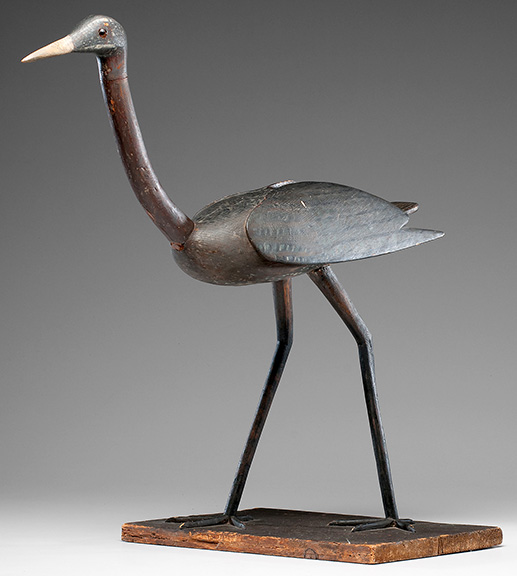
Carved and painted great blue heron decorative confidence decoy, possibly by “Chief” Eugene Cuffee (1866-1941) of Shinnecock Reservation or William Henry Bennett (1867-1954), second quarter of the 20th century, 30" high, missing one eye, old repair to bill, some paint loss, scratches, and age cracks, $8400.
The biggest disappointment among the Benkard material was a French Empire ormolu mantel clock by DuBuc, 1815-17, made of brass and having a figure of George Washington holding his resignation papers next to a shield-breasted spread-wing eagle on a sphere. Estimated at $60,000/80,000, the clock did not sell.
“That was on me,” Cowan noted. “I failed to understand the market for the clock and overestimated its value. It’s funny, when I first saw the clock in Tucson, I told the consignor that Sotheby’s original estimate of $100,000 was off the mark. The more I researched these clocks, however, the more I questioned my initial reaction; in retrospect, I was right.”
From the Sutherland collection came some of the best smalls in the sale, including a cobalt-decorated stoneware muffineer with a faceted body and top. Probably made in Ohio or Pennsylvania, it dated to the 19th century and sold for $9300. “We had a lot of interest in that presale,” said Craven. Other things drew little attention until bidding began. As she noted, “The cat was kind of a surprise.” That cat was a large chalkware seated figure with a painted and smoke-decorated surface. Of American origin and 14¾" high, it was estimated at $500/700 but brought $7500.

Salt-glazed Anna Pottery pig flask by Wallace and Cornwall Kirkpatrick of Anna, Illinois, incised and cobalt highlights, one side referring to St. Louis as “the Western New York,” the remainder with a map of Illinois landmarks and cities, dated 1889, 7½" long, chips and losses, $8400.
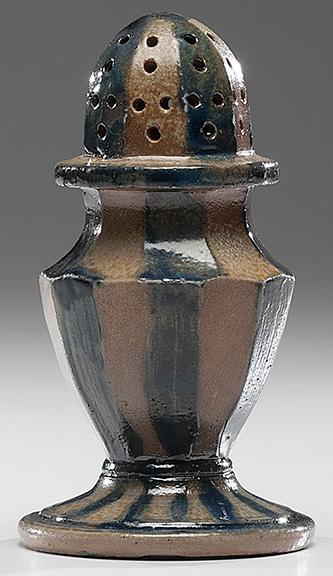
Cobalt-decorated stoneware muffineer with faceted body and top, American, probably Ohio or Pennsylvania, 19th century, 5" high, $9300.
Also from the Sutherlands were two New England brace-back Windsor side chairs in old black paint over earlier red, probably from Rhode Island, 1775-90, that sold together for $5700.
“Some of the Windsors did pretty well. There was a great selection of chairs in this sale,” said Craven.
Also in the auction were numerous clocks, including more than two dozen from the collection of Hal Wehling of Cincinnati. Included was a scroll-top Massachusetts shelf clock in mahogany with a silvered dial and newer movement by Kilbourn & Proctor that sold for $3360.
From other consignors, the mix included a pig weathervane, copper with a gold-leaf surface and a cast metal tail and ears, American, early 20th century; it sold for $10,800. “Given our location here in Porkopolis, we knew there would be some interest in him,” said Craven. “He’s a rare form and had a lot going for him.” Cincinnati became known as Porkopolis around 1835, when the city was the country’s chief hog packing center. It still proudly holds onto the moniker in a number of ways, including the Flying Pig Marathon each spring.

Copper pig weathervane, cast metal ears and tail, American, early 20th century, 15¼" (overall height) x 30", losses to old gold-leaf surface, $10,800.
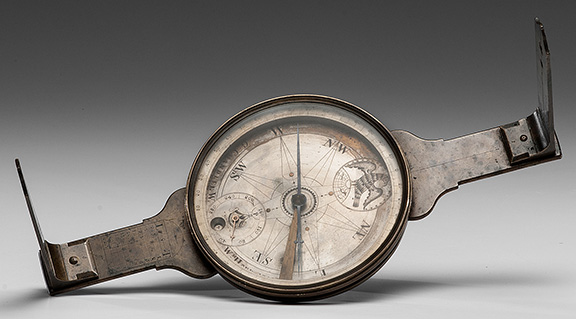
Surveyor’s plain compass, the signed work of Goldsmith Chandlee (1751-1821), marked for William Hord and dated 1808, the compass limb engraved with an “L” and “T” calculating scale, the compass face with gold watch hand, divided in both poles and miles, the north marker designated by an eagle perched on a globe, 14¼" long overall, needle 5" long, includes both its sight vanes, compass cover, and tripod with ball-and-socket joint, $13,800. Chandlee’s compasses were considered the most technically advanced of their day.
A surveyor’s plain compass by Goldsmith Chandlee (1751-1821), marked for William Hord and dated 1808, sold for $13,800. It was one of a dozen compasses offered, of which only five sold. “We had this opportunity to present this group. We wanted to test the waters to see how they would do,” said Craven. Buyers largely stuck with the better examples.
Selection also played a role in the sale of a wooden cigar-store Indian maiden wearing a feathered headdress and holding tobacco leaves. Dating to the late 19th or early 20th centuries, the figure was 68" high (including the plinth base) and in old paint but with some condition problems. It realized $16,800. “It did OK, but it didn’t exceed its expectations too much,” said Craven. One potential bidder told her he was looking at another example elsewhere, suggesting that while cigar-store Indians aren’t common, their availability is such that buyers can be choosy. “The really great examples bring top dollars. The examples of things that are not the strongest, they just don’t bring the prices, the excitement in the market,” Craven added.

Wooden cigar-store Indian maiden wearing feathered headdress and holding tobacco leaves, American, late 19th or early 20th century, 68" high including plinth base, old polychrome paint possibly the original surface, age split to chest, wear to base, and minor chips to wood and paint throughout, $16,800.
What did matter throughout the day, in addition to rarity and condition, was the freshness of much of the material. The Benkard and Sutherland collections yielded items that hadn’t been on the market in decades, and bidders responded eagerly.
For more information, phone Cowan’s at (513) 871-1670 or visit (www.cowanauctions.com).
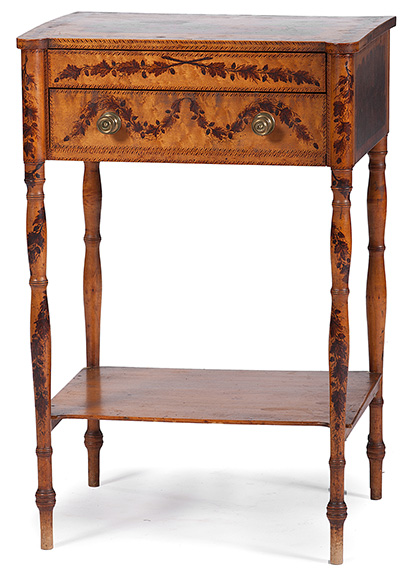
New England schoolgirl-decorated Federal sewing table with lift lid, bird’s-eye maple, painted with landscapes and floral and acorn swags, American, early 19th century, 29½" x 19½" x 15¾", original brasses, lower shelf likely a replacement, interior landscape with damage, top slightly bowed, $10,800.
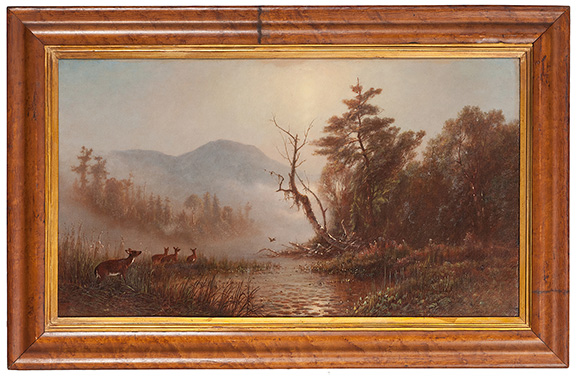
Adirondack autumn landscape by James McDougal Hart (Scottish-American, 1828-1901), signed, oil on canvas, 17½" x 30" plus frame, $19,200.
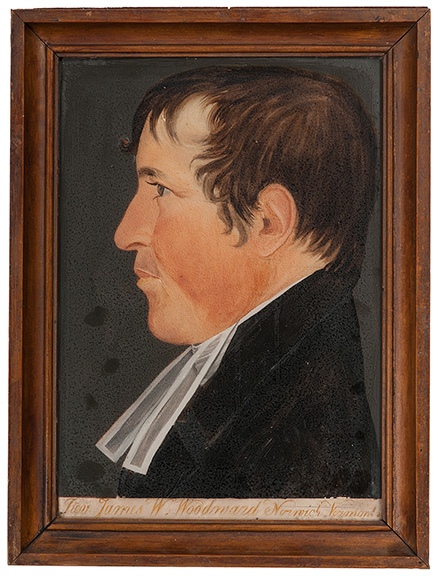
Pair of reverse-painted portraits on glass (one shown) by Benjamin Greenleaf (1769-1821) of Massachusetts and New Hampshire, of a Vermont minister and his wife, both identified, each 13½" x 9¾" plus period frame, scattered paint loss to wife’s portrait, $10,800 the pair.
Originally published in the March 2017 issue of Maine Antique Digest. © 2017 Maine Antique Digest
